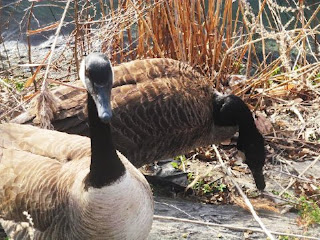|
I nearly always meet interesting people when going to Central Park to check on geese, ducks and other park wildlife. Most times these little adventures result in my providing a sort of tutorial on park wildlife to curious onlookers and nature lovers.
Last night was a little different, however.
I met a young Asian woman doing time lapse photography at the Reservoir. She had been there in the early morning to photograph the sunrise and returned in the evening to photograph the sun going down over the city.
During the course of her photography, the young woman also was able to capture nature happening right under her nose in the form of nesting geese (Hansel and Greta) protecting their eggs from wandering raccoons.
The woman was surprised and jubilant that the day brought so much in unexpected surprises. After a week of mostly flat, rainy skies with little sun, yesterday was a gift to photographers hoping to capture bright, scarlet sunrises and sunsets against vivid, contrasting clouds. Add to that, being in the right place at the right time to capture the wonders of nature under one's very eyes.
The woman then explained that yesterday was her 30th birthday. But rather than spending the day with friends who might or not disappoint, she elected to spend the time in pursuit of her own goals, personal celebration and reflection upon what the new decade might mean for her.
"I did not even tell my boyfriend of a few months that it was my birthday," she added. "I didn't want him to feel obligated."
Such struck me as extraordinary wise for one so young and so I told the young woman.
"So many of life's disappointments are after all, experienced when our expectations of others are too high and fail to be met. The reality is that most romantic breakups occur around Christmas, birthdays and Valentine's Day," I laughed. "We expect cards, romantic dinners and roses and too often end up with excuses or argument. You are wise to seek and find your own happiness."
I then shared with the young woman my own experience of spending my thirty-fourth birthday getting drunk with friends and then coming home to learn John Lennon had just been shot to death outside the Dakota. "The day forever lives in infamy," I chuckled.
The young woman then told me of her love for the Beatles and how they are her favorite band even so many decades after the fact.
I was never a great fan of the Beatles (Bob Dylan was my favorite musical act), but I have to admit something of innocence, love and simplicity was lost the day Lennon was so violently and suddenly gunned down on the streets of New York City.
The question is, can we ever get those things back?
But perhaps this young person seeking and finding her own independence and happiness in life while still appreciating the wisdom and innocence of days past is sign that there is always hope. -- PCA
*******
































